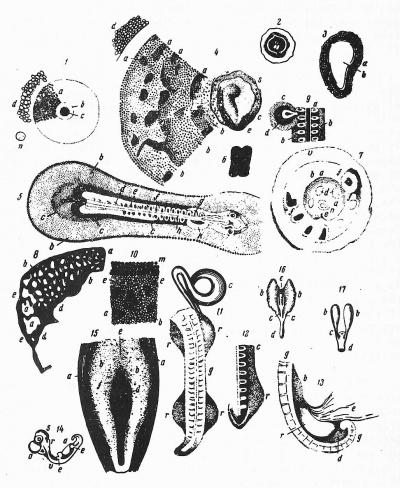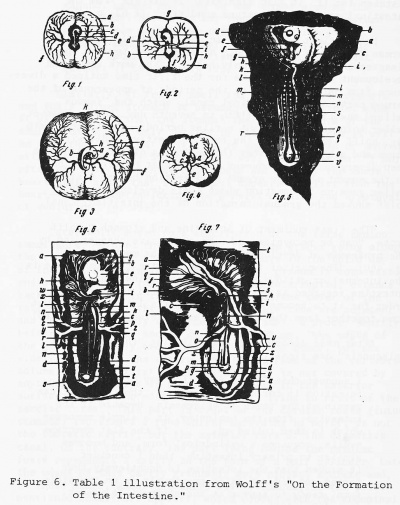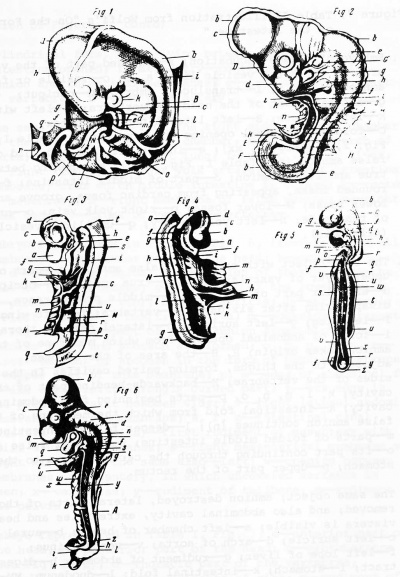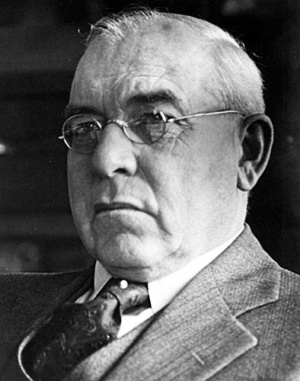Embryology History - Caspar Wolff: Difference between revisions
mNo edit summary |
m (→Images) |
||
| Line 50: | Line 50: | ||
| Kaspar Friedrich Wolff | | Kaspar Friedrich Wolff | ||
| Wolff's chicken development | | Wolff's chicken development | ||
|- | |- | ||
| [[File:Blyakher1955 fig06.jpg|400px]] | | [[File:Blyakher1955 fig06.jpg|400px]] | ||
Latest revision as of 23:34, 10 May 2018
Introduction
Caspar Friedrich Wolff (1734-1794) was a German embryologist and anatomist best known today for the structures bearing his name: & Wolffian body - mesonephros
- Wolffian duct - mesonephric duct
- Wolffian cyst - mesonephric origin uterine broad ligament cyst
Thought also to be a founder of the germ layer theory. His doctorate dissertation Theoria generationis (1774) discarded the developmental theory of preformation.
Later in his career, his teaching in Berlin was opposed by the professors of the Medical-Surgical College, who had guild privileges to teach medicine.
- Links: genital | renal | Germ Layer Theory
| Embryologists: William Hunter | Wilhelm Roux | Caspar Wolff | Wilhelm His | Oscar Hertwig | Julius Kollmann | Hans Spemann | Francis Balfour | Charles Minot | Ambrosius Hubrecht | Charles Bardeen | Franz Keibel | Franklin Mall | Florence Sabin | George Streeter | George Corner | James Hill | Jan Florian | Thomas Bryce | Thomas Morgan | Ernest Frazer | Francisco Orts-Llorca | José Doménech Mateu | Frederic Lewis | Arthur Meyer | Robert Meyer | Erich Blechschmidt | Klaus Hinrichsen | Hideo Nishimura | Arthur Hertig | John Rock | Viktor Hamburger | Mary Lyon | Nicole Le Douarin | Robert Winston | Fabiola Müller | Ronan O'Rahilly | Robert Edwards | John Gurdon | Shinya Yamanaka | Embryology History | Category:People | ||
|
Wolff as Founder of the Germ Layer Theory
This excerpt is from a series of 1930's essays by Arthur William Meyer on the history of embryology.
Meyer AW. Essays on the History of Embryology: Part VI. Cal West Med. 1932 May;36(5):341-3. PMID 18742132
By a very careful series of observations on incubating hen eggs, Wolff showed that the different organs are not present in the egg in miniature, but result from the growth, folding and fusion of a few strata which we now know as germ layers. Wolff traced and represented the development of the amnion, stomach, intestine, and the neural tube, and was the real founder of the germ layer theory. It was he who placed the theory of epigenesis on an unshakable foundation of direct observation and converted it into a law for many forms of beings at least.
Wolff stated that the different organs and organ systems are formed after each other, and declared that some organs which have a totally different function may, nevertheless, arise from the same germ layer, saying:
- “It appears as though at different periods, and many times become formed after one and the same type, and as if they might be on that account similar to one another, even though they are in reality different. The system which is first produced, which is first to take on a specific form, is the nervous system. When this is concluded, then the fleshy mass, which really makes up the embryo, is formed after the same type; then appears‘ a third, the vascular system, which certainly is not so unlike the first ones that the form described as common to all systems could not be easily recognised in it. After this follows the fourth, the intestinal canal, which, again, is formed after the same type, and appears as a completed independent whole, similar to the first three."
Wolff humbly and in a very exemplary way added that he was unable to see any of the causes which produce these changes, and that he therefore had nothing to say about them. Although his investigation of the development of the chick still is regarded as the most outstanding embryological investigation done up to that time, it attracted little attention at first, and the German edition of his observations, which was not published until forty-four years after the Latin edition, appeared some time after his death. As a result of W0lff’s work, the theory of preformation was finally abandoned at the end of the eighteenth century except by a few, and has had only an historical interest since.
Wolff’s earlier work, published as a thesis in his young manhood, has not yet received due recognition, for as stated by Gilis, he described globules in the homogeneous mass in which the embryo was formed, such as could be seen in young plants. This observation implied the discovery of the cell at least after the manner of Malpighi, and Wolf? also saw blood islands and veins form in the same mass.
Images

|

|
| Kaspar Friedrich Wolff | Wolff's chicken development |

|

|
External Links
External Links Notice - The dynamic nature of the internet may mean that some of these listed links may no longer function. If the link no longer works search the web with the link text or name. Links to any external commercial sites are provided for information purposes only and should never be considered an endorsement. UNSW Embryology is provided as an educational resource with no clinical information or commercial affiliation.
- Internet Archive - Theoria generationis
- Whonamedit - Caspar Friedrich Wolff
Cite this page: Hill, M.A. (2024, April 18) Embryology Embryology History - Caspar Wolff. Retrieved from https://embryology.med.unsw.edu.au/embryology/index.php/Embryology_History_-_Caspar_Wolff
- © Dr Mark Hill 2024, UNSW Embryology ISBN: 978 0 7334 2609 4 - UNSW CRICOS Provider Code No. 00098G


